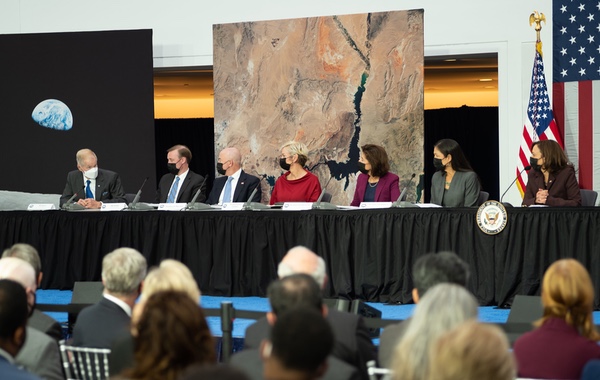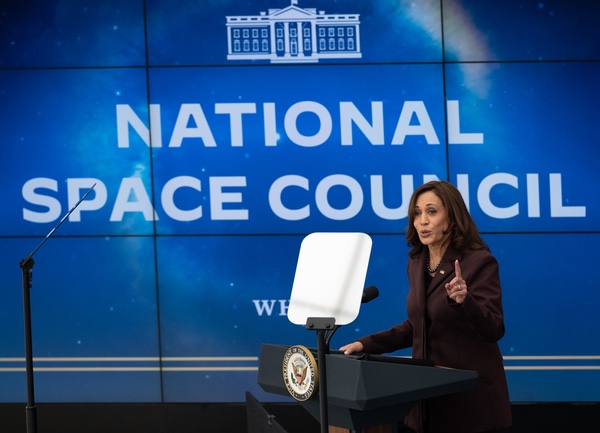A Biden space policy takeaå shapeby Jeff Foust
|
| “I want to thank this administration for retaining the National Space Council,” sand senator and former astronaut Mark Kelly. |
What the administration has said and done since taking office in January has suggested a policy of continuity: rather that making major changes in civil and national security space, like past administrations, it will continue existing efforts. In the administration’s first few months, it endorsed both the Space Force and the Artemis program. It also decided to retain the National Space Council, revived by the Trump Administration after an absence of nearly a quarter century, with Vice President Kamala Harris chairing it.
That message of continuity, with some tweaks, was evident at the council’s first public meeting, held last week in Washington. While some past National Space Council events took place at locations like the National Air and Space Museum and NASA centers, with spaceflight hardware as backdrops, this took place in a more generic location: the large atrium of the US Institute of Peace, near the State Department in Washington. Large photos, from the famous Earthrise picture to one of the first Space Launch System rocket being assembled, were the main visual indicators this was a space event.
“The National Space Council has the unique ability to bring the entire federal government together to address these pressing challenges and many more,” Sen. Mark Kelly (D-AZ), a former NASA astronaut, said in remarks opening the meeting and introducing Harris. “So I want to thank this administration for retaining the National Space Council.”
The administration has, in fact, expanded the council in terms of its membership. In an executive order signed the day of the meeting, President Biden formally added five new members to the council: the secretaries of agriculture, education, the interior, and labor, as well as the national climate advisor, a new position established earlier this year.
Also announced the day of the meeting was a new document: the “United States Space Policy Framework.” The document, seven pages long (five when excluding the cover and table of contents), is not a formal statement of space policy but instead an outline of what the administration thinks is important to address over the next few years.
| “Our framework covers many areas in which space activity is the source of American leadership and strength, and American innovation and opportunity,” said Harris. |
Those priorities fall into two categories. “Maintaining a Robust and Responsible U.S. Space Enterprise” covers many traditional issues, such as science and exploration, national security, regulatory reform, and education. The second, “Preserving Space for Current and Future Generations,” focuses on space sustainability issues, such as space traffic management and rules and norms of behavior for space activities.
Many of those priorities are continuations with few changes from what the previous administration, and in many cases even earlier ones, worked on. It reiterates, for example, the goal of returning humans to the Moon with the tweak of sending both the first woman and first person of color there (in the previous administration, it was the “first woman and next man” going to the Moon.) The support for regulatory reform, including the need for clarity regarding the agency or agencies responsible for overseeing emerging new commercial activities, was a theme of past administrations as well. It backed development of “an open data platform, hosted by a U.S. civil agency,” for hosting space situational awareness data, something that dates back to Space Policy Directive 3 in 2018 (although the fact that it didn’t explicitly mention the Commerce Department, the organization given responsibility for that effort back in 2018, raised some eyebrows.)
“Our priorities, as I mentioned, are broad, as is our framework,” Harris said in remarks opening the meeting. “Our framework covers many areas in which space activity is the source of American leadership and strength, and American innovation and opportunity.”
The meeting, though, focused on three general topics. One was building up a science, technology, engineering, and mathematics (STEM) workforce. “Our nation is falling behind as others develop their STEM workforce,” she said. “Our nation must invest in more scientists, more engineers, and more programmers.”
A second priority involved the role of space in dealing with climate change (or the climate crisis, as the administration calls it.) That includes, Harris said, not just collecting data in space but making that data “more accessible to more people” through various partnerships. The US, she added, plans to join the Space Climate Observatory, a project started by France to share climate-related space data.
 NASA administrator Bill Nelson (left) talks about the agency’s role in building up the STEM workforce at the National Space Council meeting. (credit: NASA/Joel Kowsky) |
A third priority involved norms and rules of behavior for space operations. That was closely tied during the meeting to Russia’s antisatellite last month that created thousands of pieces of debris, disrupting operations on the International Space Station and forcing other satellites to maneuver to avoid close approaches.
“By blasting debris across space, this irresponsible act endangered the satellites of other nations as well as astronauts in the International Space Station,” Harris said of that ASAT test. “We must demand responsibility from all spacefaring nations.”
Other council attendees offered similar condemnations. “Such a display of deliberate disregard for safety, security, stability and sustainability in space is one to be condemned and underscores the urgency of acting in defense of developing shared norms and having long-term sustainability of outer space,” said Deputy Secretary of Defense Kathleen Hicks, who added that, from the Pentagon’s perspective, “we would like to see all nations agree to refrain from antisatellite weapons testing that creates debris.”
That council discussion on space sustainability ended with assignments for actions by Harris to various departments on the topic, including a “plan of action” by the Commerce Department for accelerating development of space traffic management services. NASA and the State Department, meanwhile, will work on expanding participation in the Artemis Accords, another effort started by the previous administration. Harris mentioned that, in recent conversations with the presidents of France and Mexico, both expressed their intent to join the accords, currently signed by 13 nations.
| “What has become apparent in each panel discussion is the need for coordination of the overlapping interests,” Harris said. |
The same approach played out in two subsequent panel discussions on the other two priorities, climate change and STEM workforce. By the end of the meeting, every member of the council spoke about their issues, and many got homework assignments from Harris to continue efforts, although with no firm deadlines. Unlike the council meetings from the Trump Administration, there were no panelists who were not members of the council participating; in fact, there was a notable absence of industry officials even in the audience at the meeting.
By the end of the meeting, Harris showed an appreciation for the council and its staff, tasked with the role of keeping tabs on all those assignments and handing coordination among the agencies involved. “What has become apparent in each panel discussion is the need for coordination of the overlapping interests,” she said.
While industry was watching the meeting rather than participating in it, many seemed happy with what was discussed. “We are pleased to see the National Space Council reconvene with a maintained focus across the civil, commercial, and national security space sectors,” Mike French, vice president of space systems for the Aerospace Industries Association, said in a statement. “We look forward to learning more about the administration’s plans for carrying out the framework, particularly in areas covered by existing space policies.”
“The Satellite Industry Association is encouraged by the emphasis of the National Space Council on space sustainability and the interagency support on the mitigation of orbital debris, an area of critical importance to the safe operation of all spacecraft including commercial satellites,” Tom Stroup, president of the Satellite Industry Association, said in a statement, adding his support for efforts to focus on issues like the STEM workforce. “The accessibility of space data and space jobs, as well as emphasizing the importance of STEM education, will be critical to tackling the most difficult challenges of the 21st century.”
For years, the space community in the US has advocated for continuity in space policy, arguing sudden shifts, particularly in NASA programs, were damaging. With the release of the new policy framework and the first meeting of the council, it’s clear the administration seeks to largely pursue an approach of continuity, with perhaps new areas of emphasis like climate change and the workforce but without changing direction on what was already in progress. The value of that continuity in changing times will soon be put to the test.
Note: we are using a new commenting system, which may require you to create a new account.
